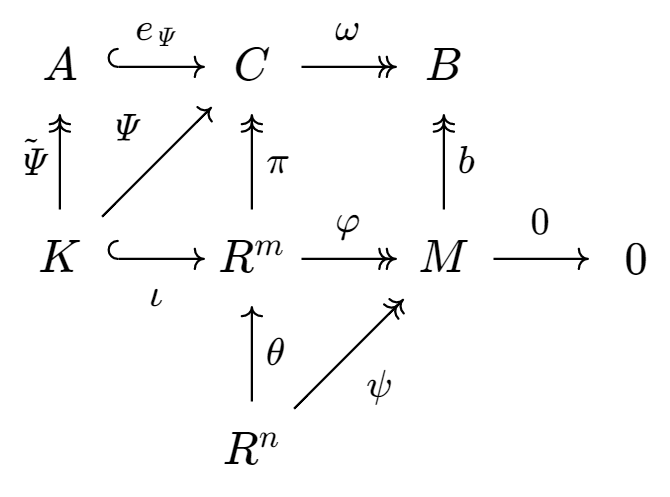(2) Hint: Let $(C,\pi)$ be cokernel of $\theta$, $(K,\iota)$ be kernel of $\varphi$. Here $\varPsi$ is defined as the composition $\pi\circ \iota$. $K\overset{\tilde \varPsi}\twoheadrightarrow A\overset{e_\varPsi}\hookrightarrow C$ is the inject-surject decomposition of $\varPsi$. Therefore $(K\overset{\tilde \varPsi}\twoheadrightarrow A,(\iota,e_\varPsi))$ is the kernel of $R^m\overset\pi\twoheadrightarrow C$ in the corresponding morphism category ${_R}\mathrm{Mod}^\to$, $M\overset b\twoheadrightarrow B$ is the cokernel. The commutative diagram reveals that
$$
\omega\circ \pi\circ \theta=b\circ \psi:R^n\to B
$$
is surjective, but also zero ($\pi\circ \theta=0$ by definition of exact sequences). Thus $B=0$. The exactness of $A\overset {e_\varPsi}\hookrightarrow C\overset\omega\twoheadrightarrow B$ is induced by the exact sequence $\boxed{\substack{K\\\downarrow\\A}}\hookrightarrow \boxed{\substack{R^m\\\downarrow\\C}}\twoheadrightarrow \boxed{\substack{M\\\downarrow\\B}}$, hence $e_\varPsi$ is isomorphism. Consequently, $\varPsi$ is surjective.
Morphism category = viewing morphisms as new objects.
Le diagramme est commutatif for the second part.
Le diagramme commutatif de Ex.2
